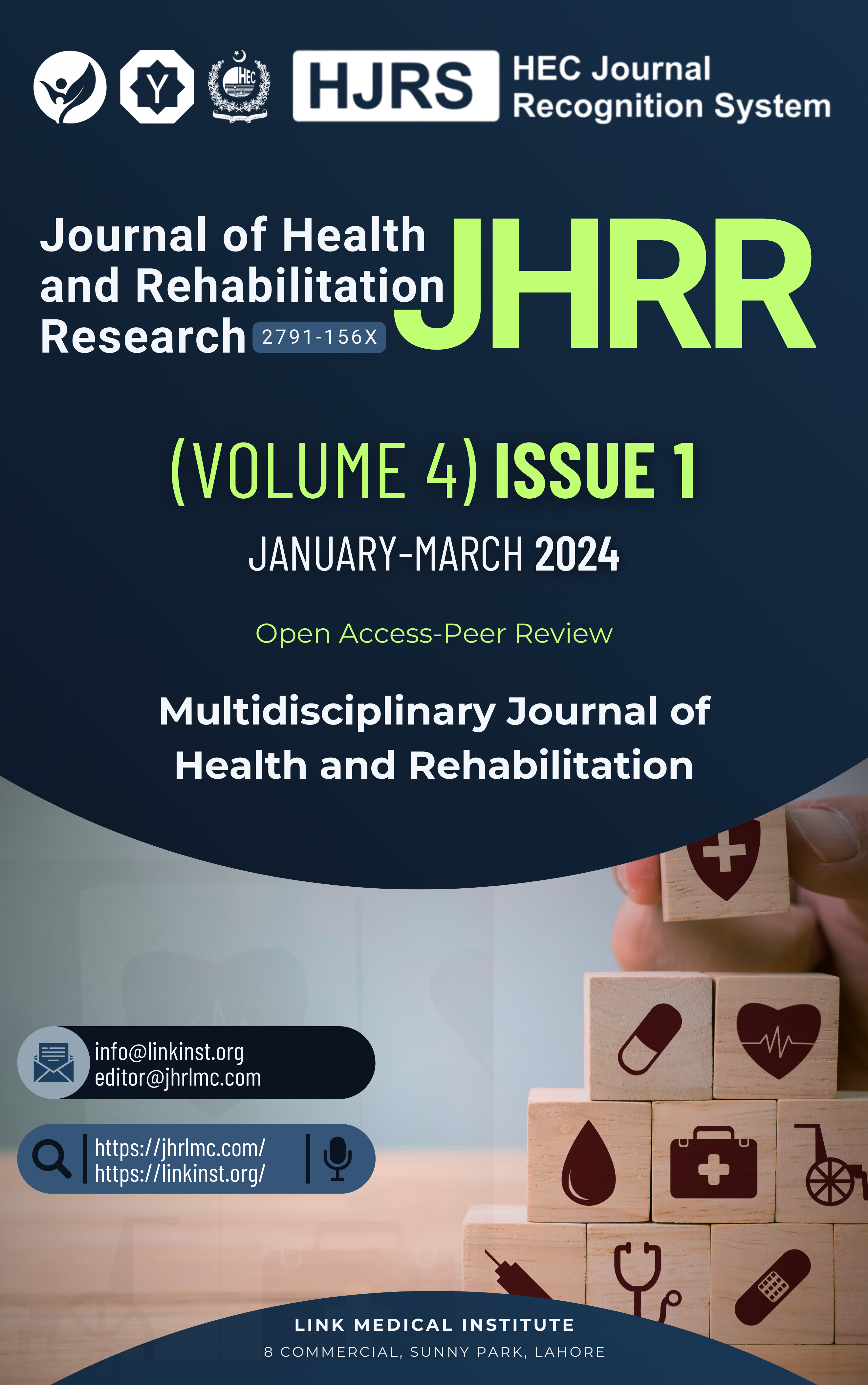Clinical Outcome of Ferric Sulfate Versus Formocresol Pulpotomy in Vital Pulp Therapy
DOI:
https://doi.org/10.61919/jhrr.v4i1.1739Keywords:
Vital pulpotomy, primary molars, formocresol, ferric sulfate, pediatric dentistry, restoration materials, glass ionomer cement, clinical outcomesAbstract
Background: Vital pulpotomy in primary molars is essential for preserving dental health and function in pediatric patients. Formocresol (FC) has long been considered the gold standard, while ferric sulfate (FS) is an emerging alternative due to its bacteriostatic and hemostatic properties.
Objective: To assess and compare the clinical effectiveness of formocresol and ferric sulfate as pulpotomy agents in primary molars.
Methods: A comparative observational study was conducted at Bolan Medical College/Sandeman Provincial Hospital, Quetta. A total of 179 pediatric patients (aged 23 months to 10.1 years, mean 74.09 ± 20.75 months) underwent pulpotomy on 300 primary molars using FC (single-visit: 109 teeth, two-visit: 117 teeth) and FS (50 teeth). Clinical outcomes were evaluated at 6–12, 13–24, and 25–36 months post-treatment through standardized clinical and radiological assessments. Success rates, complications, and correlations with restoration materials were analyzed using SPSS 25. Statistical significance was set at p < 0.05.
Results: The two-visit FC protocol achieved the highest success rate (90.6%), followed by FS (84.0%) and single-visit FC (77.1%). GIC restorations showed fewer complications (2.7% at 6–12 months) compared to composites (11.6%, p = 0.028). Odds ratio for complications was significantly lower with GIC (OR = 2.21, 95% CI: 1.09–4.88).
Conclusion: Both formocresol and ferric sulfate were effective pulpotomy agents, with two-visit FC protocols achieving superior outcomes. Glass ionomer cement demonstrated the lowest complication rates and should be prioritized in restorative treatments.
Downloads
References
Christensen JR, Fields HW. Space Maintenance in the Primary Dentition. Pediatric Dentistry - Infancy Through Adolescence. 2012;5:379.
McDonald RE, Avery DR, Hartsfield JK Jr. Acquired and Developmental Disturbances of the Teeth and Associated Oral Structures. Dentistry for the Child and Adolescent. 9th ed. St. Louis, MO: Mosby Inc.; 2010. p. 85-125.
Sirohi K, Marwaha M, Gupta A, Bansal K, Srivastava A. Comparison of Clinical and Radiographic Success Rates of Pulpotomy in Primary Molars Using Ferric Sulfate and Bioactive Tricalcium Silicate Cement: An In Vivo Study. Int J Clin Pediatr Dent. 2017;10(2):147-51.
Coll JA, Seale NS, Vargas K, Marghalani AA, Al Shamali S, Graham L. Primary Tooth Vital Pulp Therapy: A Systematic Review and Meta-Analysis. Pediatr Dent. 2017;39(1):16-23.
Pitts NB. The Use of Bitewing Radiographs in the Management of Dental Caries: Scientific and Practical Considerations. Dentomaxillofac Radiol. 1996;25(1):5-16.
Baelum V, van Palenstein Helderman W, Hugoson A, Yee R, Fejerskov O. A Global Perspective on Changes in the Burden of Caries and Periodontitis: Implications for Dentistry. J Oral Rehabil. 2007;34(12):872-906.
Ward J. Vital Pulp Therapy in Cariously Exposed Permanent Teeth and Its Limitations. Aust Endod J. 2002;28(1):29-37.
Fuks AB, Kupietzki A, Guelmann M. Pulp Therapy for the Primary Dentition. Pediatric Dentistry - Infancy Through Adolescence. 2012;5:333.
Kurji ZA. Outcomes of a Modified Pulpotomy Technique [master’s thesis]. Toronto: University of Toronto; 2009.
Ozmen B, Bayrak S. Comparative Evaluation of Ankaferd Blood Stopper, Ferric Sulfate, and Formocresol as Pulpotomy Agents in Primary Teeth: A Clinical Study. Niger J Clin Pract. 2017;20(7):832-8.
Pandiyan R, Lehl GK, Kumar R, Sharma U, Jagachandiran VV. Assessing the Efficacy of Laser Pulpotomy Versus Conventional Pulpotomy in Primary Teeth: A Systematic Review and Meta-Analysis of Clinical Trials. Lasers Med Sci. 2024;39(1):198.
Lin PY, Chen HS, Wang YH, Tu YK. Primary Molar Pulpotomy: A Systematic Review and Network Meta-Analysis. J Dent. 2014;42(9):1060-77.
Rocha WH, Teodoro JÁ, Assis Acurcio FD, Guerra Jr AA, Gomes Moura IC, Godman B, et al. Influence of Pharmaceutical Services Organization on the Availability of Essential Medicines in a Public Health System. J Comp Eff Res. 2021;10(6):519-32.
Bossù M, Iaculli F, Di Giorgio G, Salucci A, Polimeni A, Di Carlo S. Different Pulp Dressing Materials for the Pulpotomy of Primary Teeth: A Systematic Review of the Literature. J Clin Med. 2020;9(3):838.
Frencken JE, Van’t Hof MA, Taifour D, Al-Zaher I. Effectiveness of ART and Traditional Amalgam Approach in Restoring Single-Surface Cavities in Posterior Teeth of Permanent Dentitions in School Children After 6.3 Years. Community Dent Oral Epidemiol. 2007;35(3):207-14.
Ibricevic H, Al-Jame Q. Ferric Sulfate and Formocresol in Pulpotomy of Primary Molars: Long-Term Follow-Up Study. Eur J Paediatr Dent. 2003;4:28-32.
El-Mansy IT, Albagshi A, Alahmed F, Alshakhs F, Alhabarah M, Alqahtani S, et al. Evaluation of Medicative Endodontic Materials in Primary Molar Pulpotomy: A Systematic Review. Int J Med Dev Ctries. 2021;5(3):937.
Ildeş GÇ, Sezgin BI, Vieira AR, Mentes A. A Randomized Clinical Trial of Hyaluronic Acid Gel Pulpotomy in Primary Molars With 1 Year Follow-Up. Acta Odontol Scand. 2022;80(4):273-80.
John M. A Retrospective Radiographic Evaluation of Primary Molar Pulpectomies. Pediatr Dent. 1991;1(3):1.
Iyogun CA, Orikpete EV, Mbagwu AA, Omitola OG. Odontogenic Cysts in Port Harcourt, Nigeria: A 10-Year Review. Oral Dis. 2021;27(7):1822-33.
Ostalska-Nowicka D, Paszyńska E, Dmitrzak-Węglarz M, Neyman-Bartkowiak A, Rabiega A, Zachwieja J, et al. Dental Caries-Related Primary Hypertension in Children and Adolescents: Cross-Sectional Study. Oral Dis. 2021;27(7):1822-33.
Chen Y, Zhu LL, Zhou Q. Effects of Drug Pharmacokinetics and Relevant Pharmacological Interventions on Fall Risk in Elderly Patients. Ther Clin Risk Manag. 2014;10:437-48.
Guelmann M, Fair J, Bimstein E. Permanent Versus Temporary Restorations After Emergency Pulpotomies in Primary Molars. Pediatr Dent. 2005;27(6):478-81.
Cordell SC. Randomized Controlled Clinical Trial Comparing the Success of Two Pulpotomy Agents for Primary Molars [master’s thesis]. Chicago: University of Illinois; 2010.
Afkhami F, Wright PP, Chien PY, Xu C, Walsh LJ, Peters OA. Exploring Approaches to Pulp Vitality Assessment: A Scoping Review of Nontraditional Methods. Int Endod J. 2024;57(4):202-10.
Downloads
Published
How to Cite
Issue
Section
License
Copyright (c) 2024 Shazmeen Alim, Syed Atta Ullah Shah, Sadia Malik, Farhat Fatima, Rahim Jan

This work is licensed under a Creative Commons Attribution 4.0 International License.
Public Licensing Terms
This work is licensed under the Creative Commons Attribution 4.0 International License (CC BY 4.0). Under this license:
- You are free to share (copy and redistribute the material in any medium or format) and adapt (remix, transform, and build upon the material) for any purpose, including commercial use.
- Attribution must be given to the original author(s) and source in a manner that is reasonable and does not imply endorsement.
- No additional restrictions may be applied that conflict with the terms of this license.
For more details, visit: https://creativecommons.org/licenses/by/4.0/.






